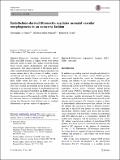Endothelium-derived fibronectin regulates neonatal vascular morphogenesis in an autocrine fashion
Author(s)
Turner, Christopher; Hynes, Richard O.; Badu-Nkansah, Kwabena
Download10456_2017_Article_9563.pdf (8.889Mb)
PUBLISHER_CC
Publisher with Creative Commons License
Creative Commons Attribution
Terms of use
Metadata
Show full item recordAbstract
Fibronectin containing alternatively spliced EIIIA and EIIIB domains is largely absent from mature quiescent vessels in adults, but is highly expressed around blood vessels during developmental and pathological angiogenesis. The precise functions of fibronectin and its splice variants during developmental angiogenesis however remain unclear due to the presence of cardiac, somitic, mesodermal and neural defects in existing global fibronectin KO mouse models. Using a rare family of surviving EIIIA EIIIB double KO mice, as well as inducible endothelial-specific fibronectin-deficient mutant mice, we show that vascular development in the neonatal retina is regulated in an autocrine manner by endothelium-derived fibronectin, and requires both EIIIA and EIIIB domains and the RGD-binding α5 and αv integrins for its function. Exogenous sources of fibronectin do not fully substitute for the autocrine function of endothelial fibronectin, demonstrating that fibronectins from different sources contribute differentially to specific aspects of angiogenesis.
Date issued
2017-06Department
Massachusetts Institute of Technology. Department of Biology; Koch Institute for Integrative Cancer Research at MITJournal
Angiogenesis
Publisher
Springer-Verlag
Citation
Turner, Christopher J.; Badu-Nkansah, Kwabena and Hynes, Richard O. “Endothelium-Derived Fibronectin Regulates Neonatal Vascular Morphogenesis in an Autocrine Fashion.” Angiogenesis 20, 1 (June 2017): 1-13 © 2017 The Author(s)
Version: Final published version
ISSN
0969-6970
1573-7209